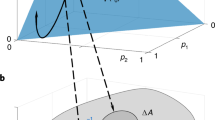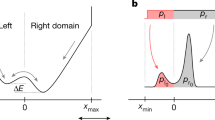Abstract
THE temperature scale recently proposed by Georgian1 has stimulated us to spend some time considering both the temperature scale and the dimensions to be associated with temperature. We shall begin by outlining details of various temperature scales which have been suggested during the past hundred years: Rücker, 18892. Let one degree be the temperature increase required to add one erg of energy to 1 c.c. of air at 0° C and one atmosphere. Rücker made his suggestion exempli gratia, saying that “… our knowledge of the molecular construction and dynamics of solids and liquids is as yet too imperfect to warrant an attempt to place thermal units on a natural and mechanical basis”. Planck, 19123. k = 1—the degree is defined by setting Boltzmann's constant equal to unity. This was part of a system of “natural units” in which the units for mass, length, and time were defined by setting the velocity of light, the gravitational constant, and Planck's constant equal to unity. Lewis and Adams, 19144. k = 1 defines the degree, as with Planck. This was part of a system of “ultimate rational units” in which the velocity of light, the charge on the electron, and the mass of the electron were made equal to unity. Lewis and Adams also considered the possibility of R = 1 (universal gas constant per mole), but preferred k = 1. Mc Adie, 19175. Melting ice at 1,000 kilobars is defined as 1,000° N (for New), with zero at absolute zero. This scale was selected as convenient for meteorological data. Worthing, 19406. Discusses several possibilities and rejects them all. Brown, 19427. The temperature of a system is defined as the specific pressure-volume energy (in ergs/g) of hydrogen in thermal equilibrium with the system. With all measurements thus referred to a specific thermometric gas, temperature can be considered proportional to the mean square velocity of the molecules of this particular gas, and its dimensions can be taken as L2T−2. Laws, 19628. Let one degree be the temperature increase required to add one joule of energy to 1 g of water. Georgian, 19641. R = 1, in conjunction with the metre–kilogram–second (M.K.S.) system.
This is a preview of subscription content, access via your institution
Access options
Subscribe to this journal
Receive 51 print issues and online access
$199.00 per year
only $3.90 per issue
Buy this article
- Purchase on Springer Link
- Instant access to full article PDF
Prices may be subject to local taxes which are calculated during checkout
Similar content being viewed by others
References
Nature, 201, 695 (1964).
Phil. Mag., 27, 104 (1889).
The Theory of Heat Radiation, second ed., 173 (reprinted by Dover, New York, 1959).
Phys. Rev., 3, 92 (1914).
Phys. Rev., 9, 91 (1917).
Amer. J. Phys., 8, 28 (1940).
Phil. Mag., 33, 543 (1942).
New Scientist, 13, 100 (Jan. 11, 1962).
Phil. Mag., 35, 73 (1944).
Nature, 203, 1158 (1964).
Dimensional Methods, 70 (Edward Arnold, London, 1953).
Proc. Phys. Soc., 54, 504 (1942).
The Method of Dimensions, 50 and 62 (Methuen and Co., London, 1933).
Nature, 207, 1285 (1965).
Bridgman, Dimensional Analysis, revised ed. (Yale University Press, 1931).
Author information
Authors and Affiliations
Rights and permissions
About this article
Cite this article
COLLINS, F., BROWNSCOMBE, E. The Temperature Scale. Nature 211, 956–957 (1966). https://doi.org/10.1038/211956a0
Issue Date:
DOI: https://doi.org/10.1038/211956a0
Comments
By submitting a comment you agree to abide by our Terms and Community Guidelines. If you find something abusive or that does not comply with our terms or guidelines please flag it as inappropriate.



